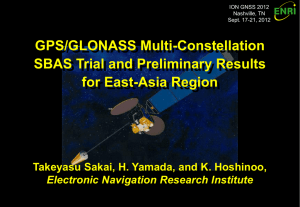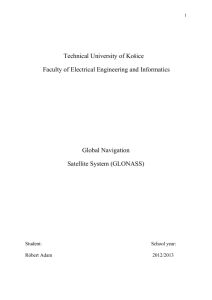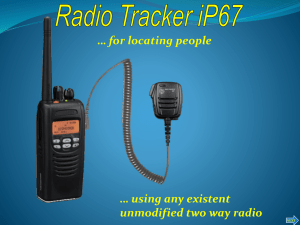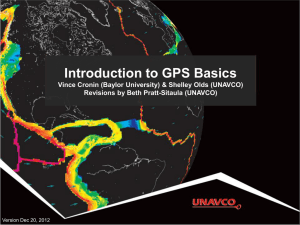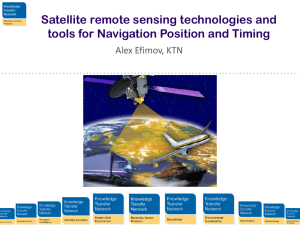IWG25_ENRI_MC
advertisement
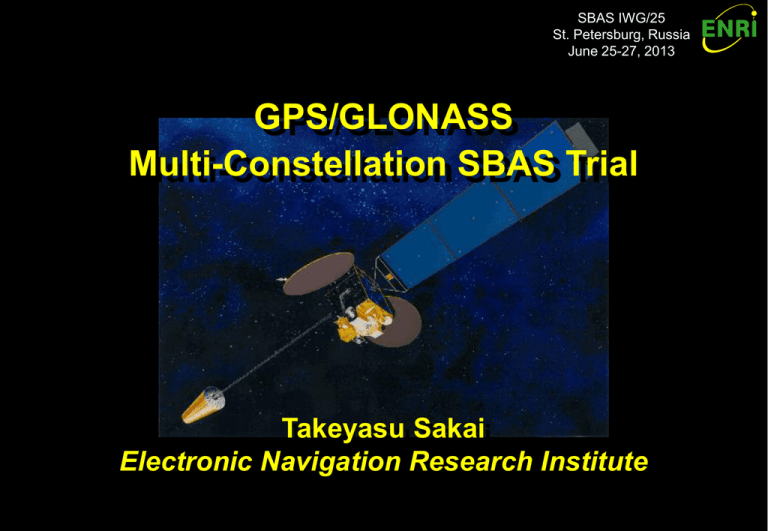
SBAS IWG/25 St. Petersburg, Russia June 25-27, 2013 GPS/GLONASS Multi-Constellation SBAS Trial Takeyasu Sakai Electronic Navigation Research Institute IWG/25 June 2013 - Slide 1 Introduction • Combined use of GPS and GLONASS with SBAS augmentation: – GPS/GLONASS-capable receivers are now widely available; – SBAS (satellite-based augmentation system) is an international standard of the augmentation system; US WAAS, Japanese MSAS, and European EGNOS are already operational; – All operational SBAS are augmenting only GPS; – To improve availability of SBAS-augmented position information, a possible way is extending SBAS to support an additional constellation, e.g., GLONASS. • Possibility of Multi-Constellation SBAS (MC SBAS): – SBAS specification already has definitions necessary to augment GLONASS; – Investigating advantages of using GLONASS, we have implemented SBAS simulator capable of augmenting both GPS and GLONASS simultaneously; – It is confirmed that introducing GLONASS improves availability and robustness of position information especially where visibility is limited. IWG/25 June 2013 - Slide 2 Motivation SBAS GEO Augmentation GPS Constellation Additional Constellation = GLONASS • Increase of augmented satellites improves availability of position solution; • Also possibly reduce protection levels; Improve availability of navigation; • Chance of robust position information at mountainous areas and urban canyons. IWG/25 June 2013 - Slide 3 Current SBAS Standard • Already has definition of GLONASS: – The SBAS standard is documented as the ICAO SARPS; – GLONASS L1 CSA (channel of standard accuracy) signal has already been described in the SBAS standard based on GLONASS ICD; – SBAS signal is also able to contain information on GLONASS satellites. • Differences from GPS in terms of SBAS augmentation: (1) FDMA signals; (2) Reference time and coordination system; (3) PRN mask numbers; (4) Missing IOD for ephemeris; and (5) Satellite position computation. The SBAS standard in the Annex to the Civil Aviation Convention IWG/25 June 2013 - Slide 4 (1) FDMA Signals • FCN (Frequency Channel Number): – GLONASS ICD defines FCN of –7 to +13; – Historically 0 to +13 were used; After 2005 the range of FCN shifts to –7 to +6; – FCN cannot be used for identification of satellites; two satellites share the same FCN. • Difference of carrier frequency affects: – Carrier smoothing: Wave length per phase cycle is dependent upon carrier frequency. – Ionospheric corrections: Ionospheric propagation delay is inversely proportional to square of carrier frequency. (GLONASS ICD v5.0) IWG/25 June 2013 - Slide 5 (2) Time and Coordinate Systems • GLONASS Time: – GLONASS is operating based on its own time system: GLONASS Time; – The difference between GPS Time and GLONASS Time must be taken into account for combined use of GPS and GLONASS; – The difference is not fixed and slowly changing: about 400ns in July 2012; – SBAS broadcasts the difference by Message Type 12; GLONASS-M satellites are transmitting the difference as parameter tGPS in almanac (non-immediate) data: tGPS = tGPS − tGLONASS. • PZ-90 Coordinate System: – GLONASS ephemeris is derived based on Russian coordinate system PZ-90; – The relationship between WGS-84 and the current version of PZ-90 (PZ-90.02) is defined in the SBAS standard as the equation: – No need for PZ-90.11 ? IWG/25 June 2013 - Slide 6 (3) PRN Mask • PRN Mask: – SBAS transmits PRN mask information indicating satellites which are augmented by the SBAS; – PRN number has range of 1 to 210; – Up to 51 satellites out of 210 can be augmented simultaneously by the single SBAS signal; But, 32 GPS + 24 GLONASS = 56 !!! PRN definition for SBAS PRN Contents 1 to 37 GPS 38 to 61 GLONASS slot number plus 37 62 to 119 Spare 120 to 138 SBAS 139 to 210 Spare • A solution: Dynamic PRN Mask – Actually, PRN mask can change; Controlled by IODP (Issue of Data, PRN Mask); RTCA MOPS states this occurs “infrequently” while ICAO SARPS does not. – Change PRN mask dynamically (for GLONASS satellites only; semi-dynamic PRN masking) to reflect the actual visibility from the intended service area; – This is a tentative implementation for this MC-SBAS trial by ENRI. IWG/25 June 2013 - Slide 7 (4) IOD (Issue of Data) • IOD indicator along with corrections: – LTC (Long-Term Correction) in SBAS Message Type 24/25 contains orbit and clock corrections; – Such corrections depend upon ephemeris data used for position computation; – IOD indicates which ephemeris data should be used in receivers. • IOD for GPS satellites: – For GPS, IOD is just identical with IODE of ephemeris data. Previous Ephemeris IODE=a Next Ephemeris IODE=b Time LTC IOD=a LTC IOD=a LTC IOD=a LTC IOD=b LTC IOD=b IWG/25 June 2013 - Slide 8 IOD for GLONASS • IOD for GLONASS satellites: – GLONASS ephemeris has no indicator like IODE of GPS ephemeris; – IOD for GLONASS satellites consists of Validity interval (V) and Latency time (L) to identify ephemeris data to be used: 5 MSB of IOD is validity interval, V; 3 LSB of IOD is latency time, L. – User receivers use ephemeris data transmitted at a time within the validity interval specified by L and V. Previous Ephemeris Next Ephemeris Time LTC IOD=V1|L1 Ephemeris Validity Interval V1 L1 LTC IOD=V2|L2 Ephemeris Validity Interval V2 L2 IWG/25 June 2013 - Slide 9 (5) Satellite Position • GLONASS ephemeris data: – GLONASS transmits ephemeris information as position, velocity, and acceleration in ECEF; Navigation-grade ephemeris is provided in 208 bits for a single GLONASS SV; Broadcast information is valid for 15 minutes or more. – Numerical integration is necessary to compute position of GLONASS satellites; – Note: centripental acceleration is removed from transmitted information. These terms can be computed for the specific position and velocity of SV; GLONASS ICD A.3.1.2 gives the equations below (with some corrections). Perturbation terms in ephemeris IWG/25 June 2013 - Slide 10 MC-SBAS Experiment • ENRI’s software SBAS simulator is upgraded to support GLONASS and Japan’s QZSS constellations. QZSS currently contains only 1 IGSO broadcasting PRN 193 on L1C/A; The software generates the complete SBAS message stream based on input measurements given as RINEX files. • GNSS receiver network: GEONET User Location More than 1,200 stations are GLONASS/ QZSS-capable; Data format: RINEX 2.12 observation and navigation files. • Monitor stations for this experiment: 8 Reference Stations: (1) to (8). 3 User Stations: (a) to (c); In this presentation, discussion for user (b) only. • Period: 2012/7/18 to 2012/7/20 (3 days). IWG/25 June 2013 - Slide 11 PRN Mask Transition QZSS GLONASS GPS • Reflecting our implementation, PRN mask is updated periodically at every 30 minutes; • Semi-dynamic PRN mask: GPS and QZSS satellites are always ON in the masks; • PRN masks are set ON for GLONASS satellites visible from 1 or more stations; Set OFF if not visible. • IODP (issue of Data, PRN Mask) indicates change of PRN mask at every 30 minutes. IWG/25 June 2013 - Slide 12 Elevation Angle GPS GLONASS QZSS PRN Mask Transition 5 deg @ User (b) • Rising satellites appear at 5-12 deg above the horizon; Latency due to periodical update of PRN mask without prediction by almanac; • However, GPS satellites also have similar latency; The latency of GLONASS satellites would not be a major problem. IWG/25 June 2013 - Slide 13 # of Satellites vs. Mask Angle 17 SVs 9.8 SVs 7.4 SVs @ User (b) • Introducing GLONASS satellites increases the number of satellites roughly 75%; • QZSS increases a satellite almost all day by only a satellite on the orbit, QZS-1; • Multi-constellation with QZSS offers 17 satellites for 5 deg mask angle and 9.8 satellites even for 30 deg. IWG/25 June 2013 - Slide 14 Availability vs. Mask Angle 100% Availability @ User (b) • The number of epochs with position solution decreases with regard to increase of mask angle; • Multi-constellation with QZSS achieves 100% availability even for 40 deg mask. IWG/25 June 2013 - Slide 15 User Position Error: Mask 5deg • GPS+GLO+QZS: 0.310m RMS of horizontal error at user location (b); • Looks some improvement by using multi-constellation. IWG/25 June 2013 - Slide 16 User Position Error: Mask 30deg • GPS+GLO+QZS: 0.372m RMS of horizontal error at user location (b); • Multi-constellation offers good accuracy even for 30 deg mask. IWG/25 June 2013 - Slide 17 RMS Error vs. Mask Angle 0.602m @ User (b) • User location near the centroid of reference station network; • The accuracy degrades but is maintained to 0.6m for horizontal even for 40deg mask angle by using GLONASS and QZSS as well as GPS. IWG/25 June 2013 - Slide 18 Vertical Protection Level Reduce GPS only GPS+GLO+QZS @ User (b) • Protection levels mean the confidence limit at 99.99999% confidential level; • In these chart, unsafe condition exists if there are plots at the right of the diagonal line; • GLONASS reduces VPL; This means improvement of availability of navigation. IWG/25 June 2013 - Slide 19 Conclusion • Combined use of GPS and GLONASS with SBAS: – Multi-constellation SBAS, capable of augmenting both GPS and GLONASS, and additionally QZSS, is implemented and tested successfully; – Potential problems and solutions on realizing a multi-constellation SBAS based on the current standard were investigated; – It is confirmed that the performance of SBAS-aided navigation is certainly improved by adding GLONASS, especially when satellite visibility is limited; – Adding GLONASS also reduces protection levels and thus improves availability of navigation. • Ongoing and future works: – Realtime operation test to broadcast multi-constellation augmentation information via QZSS L1-SAIF augmentation channel; Preliminary tests have been conducted often in this year successfully; – Using GLONASS observables in generation of ionospheric correction; – Mixed use of different types of receiver for reference/user stations; – Further extension to support Galileo.
